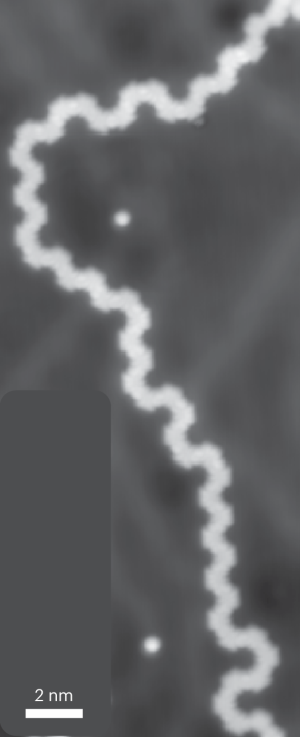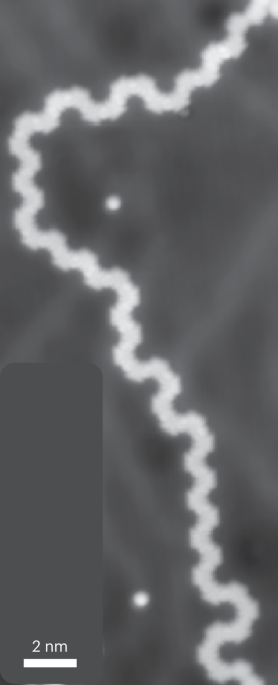One-dimensional magnetism gets the attention it deserves.
It is well known that the opposite poles of a magnet attract each other but such macroscopic observations can only tell us so much about magnetism. To dig deeper, we use tools that are sensitive to the wide variety of magnetic orders that occur in many different types of material. In three dimensions, the variety of magnetic orders are classified by magnetic space groups, similar to the crystallographic space groups for structural orders. Our understanding of three-dimensional (3D) magnetism continues to evolve through a deeper appreciation of symmetry and spin and orbital angular momentum. For example, the current focus on altermagnets, which promise new physics and application potential in terms of fast dynamics, lack of stray fields and sensitivity to external fields, is expanding the territory of conventional ferromagnets and antiferromagnets1.
 Adapted from the Article by Fasel and collaborators, under a Creative Commons licence CC BY 4.0.
Adapted from the Article by Fasel and collaborators, under a Creative Commons licence CC BY 4.0.
Moving to two dimensions, it has long been appreciated that many 3D materials behave like quasi-2D magnets, due to weak coupling between layers. Thin films deposited on substrates opened a gateway to study 2D magnetism, while freestanding van der Waals 2D magnets provided another arena to explore new physics2. Intriguingly, stacked and twisted 2D materials and heterostructured films allow for the coupling of magnetism with other long-range orders.
Compared with 3D and 2D magnets, 1D magnetism has perhaps received less attention despite 1D magnets being an excellent testbed to understand fundamental theories of quantum magnetism. In this issue of Nature Materials, we highlight recent developments in the world of 1D magnetism. Several different material platforms can be used to study 1D magnetism, including quasi-1D magnetism in 3D bulk crystals and ordered arrays of atoms and molecules deposited on substrates. Naturally, the first step is to synthesize and characterize the basic properties of such materials before their more nuanced orderings can be addressed. In their Article, Roman Fasel and collaborators build on their previous experience synthesizing graphene nanoribbons to study the chain-length dependence of magnetic excitations in these systems (pictured). The olympicene molecules forming these chains carry an effective spin-1/2 moment, allowing the authors to compare the evolution of the corresponding spin excitations of these moments using inelastic electron tunnelling spectroscopy over different chain length scales. They demonstrate an evolution from gapped to gapless excitations as the chain length increases from 2 to 50, in agreement with expectations from an antiferromagnetic spin-1/2 Heisenberg model. As highlighted in the accompanying News and Views article by Dimas de Oteyza and Bruno de la Torre, the authors have also demonstrated a single spinon, a quasiparticle fundamental to the formation of quantum spin liquids. They further highlight how the on-surface synthesis of these carbon-based nanostructures enables tests of long-standing theoretical predictions.
In another Article in this issue, Meigan Aronson and collaborators demonstrate the continued promise of bulk crystals for studying 1D magnetism. Building on their previous studies of flux-grown crystals of metallic Ti4MnBi2 that suggested linear chains of spin-1/2 magnetic moments, they co-aligned crystals of Ti4MnBi2 to yield the required mass to utilize inelastic neutron scattering, a powerful probe of magnetism and its excitations. The observed low-temperature evolution of spin excitations over the Brillouin zone, combined with their theoretical calculations, allowed them to firmly establish 1D magnetism in this material. As emphasized by Joel Moore in the accompanying News and Views article on this work, this material provides a platform to study the physics of 1D magnetism in a metallic material, which should shed light on both spin-chain physics and Kondo lattice physics.
While these works show what can be achieved through the thorough study of these two materials, they also further stimulate the search for more material systems. For example, recent works report on approaches for the on-surface synthesis of spin-1/2 nanographene chains3,4,5. These materials provide a complementary platform to those above to study the behaviour of spin excitations in one dimension.
The continued discovery of material platforms will allow for more model systems to be experimentally probed. 1D magnetism is a field where collaboration between experimental chemists and physicists and their theoretical colleagues is particularly fruitful to test basic models of quantum magnetism. We look forward to seeing how it unfolds.
